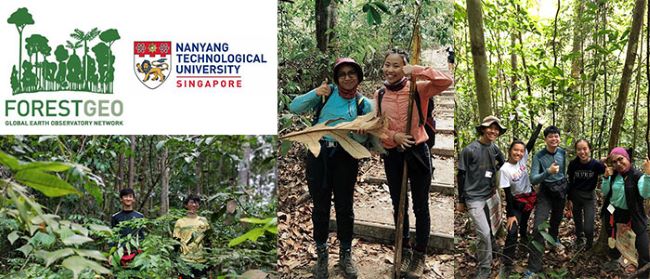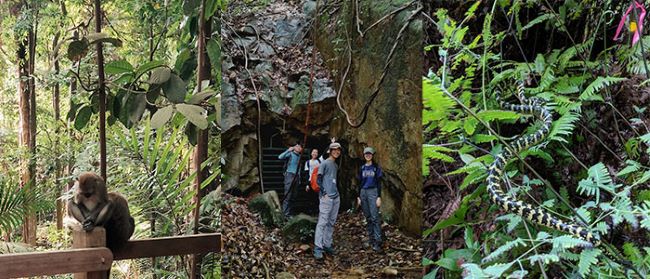Latest census of Bukit Timah forest monitoring program completed – the field team share their experience of working in the rainforest

The field team: Sylvia Tan and Siti Zaleha binte Abdullah (middle), and student volonteers (left and right).
The rich and diverse rainforest of Bukit Timah Nature Reserve is unique in Singapore because of its pristine character and a popular destination for Singapore’s nature enthusiasts. But few visitors would guess that the forest holds two 2ha research plots that are part of a global network of forest monitoring plots. The Forest Global Earth Observatory (ForestGEO), is a global network of forest research sites for studying the functioning and diversity of forests. The Bukit Timah primary forest plot was established in 1993 in collaboration with NIE, NParks, and the Arnold Arboretum of Harvard University. A secondary forest plot was established in 2004. The plots are monitored every 5 – 6 years, and the latest such census was completed in September 2019 by the persevering field team of the NTU-Smithsonian programme, comprising Sylvia Tan and Siti Zaleha binte Abdullah.
The hard-working team spent 14 months completing the full census of forest trees at Bukit Timah Nature Reserve. This included surveying all trees ≥1cm diameter within the two 2-ha plots, which add up to about 18,000 trees and more than 400 species in total. Most of the time was spent in the primary forest plots, due to the higher density and diversity of trees there. It was the seventh census for the primary forest plot, and the fourth census for the secondary forest plot. Data from the plots have contributed to our understanding of tropical forest dynamics and forest recovery in urban landscapes. The plots have also been valuable educational resources for students, supporting both undergraduate and graduate projects and class field trips. During holiday periods, the field team have had heavy involvement of ASE undergraduates. To work as a field helper is good training for the undergraduates and prepares them for doing their own project field work.

Working in the Bukit Timah forest for such a long period of time is an unusual opportunity in Singapore, and one that requires dedication and botanical skills as well as being able to deal with maps, slippery mud hills, resam ferns and venomous snakes. Field team Sylvia and Siti have written a post for the NTU-Smithsonian blog about their experiences. Here is an extract:
“The time spent in the forest turned out to be one of the most memorable experiences of our lives. Being in an urbanised country like Singapore, we are aware that this was a rare opportunity and we are extremely lucky to be given this task to work in our remaining forest. We truly felt one with nature and enjoyed working in such a beautiful, unique and serene environment. Despite the lethargy and the occasional tick bites we would receive after a day of work, we are grateful to be given an opportunity to be part of ForestGEO’s extensive research programme. We have learnt extensively regarding the important functions of the forests and why conservation and research are essential in preserving Singapore’s only hill dipterocarp forest.”
Read the full post on the NTU-Smithsonian Partnership blog here

